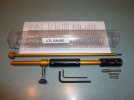If the accurate length is .010 (actual) into the lands, what does it matter if it is referred to as .005 or .015? The name you call it is irrelevant. Same with any measure off the lands, if your .020 off is actually .010 off, what does it matter? The precision comes in consistency you apply in adjusting from whatever length you started from.
I would agree for most purposes, this is the logic I use on my rifles. Even if you're using it to measure throat erosion the relative change in the datum point is what matters, not the absolute value of the measurement. None of my chambers are nice enough to need any more than that. If I had a custom chamber I would probably use another method to more accurately determine the absolute measurement, but I don't, so I don't see a need to change what I do.
I took 24 measurements (just what I did, don't remember why I did 24) on a factory 243 Win chamber last week, only one measurement was more than .001" off the mean, median, AND mode of 2.300". One outlier was removed, it was a full .010" off the average and was probably the result of me setting the rod to hold the bullet too deep in the case when inserted, so it came out of the case crooked. Concentricity matters in loaded rounds, I figure it matters in measuring the lands also, so I try to minimize the impact on the data by using an identical starting point each measurement.
My procedure is:
- Put the bullet into the modified case
- Put it into my calipers
- Push the bullet back out to the BTO measurement of book COL, and tighten the rod down
- Insert to chamber, loosen rod, push bullet forward, tighten rod, remove
- Measure and record
- Reset to the book measurement to have a consistent starting point
- Repeat a lot
I think part of my consistency is I jam the bullet in pretty hard, and still start loading at .010" off that jam. Normally I'm shorter than book COL by the time I'm at the shortest Berger recommended 0.130" off the lands testing point. Notable exception is my 300 RUM, which would be at 0.230" off the lands to get the 210 VLD to SAAMI max COL of 3.600". That just ain't happening.
I zero the calipers out and only measure how many thousands above or below an arbitrary point. To continue the 243 example, I measure to 2.300", zero the caliper, then record +1, +1, -1, -2, etc. Easier than writing down 2.301, 2.299, 2.300 each time. That's also how I check loaded rounds when they come out of the press after seating. Zero to desired BTO, and look for a variance. I use Starret dial calipers, not an electronic.

